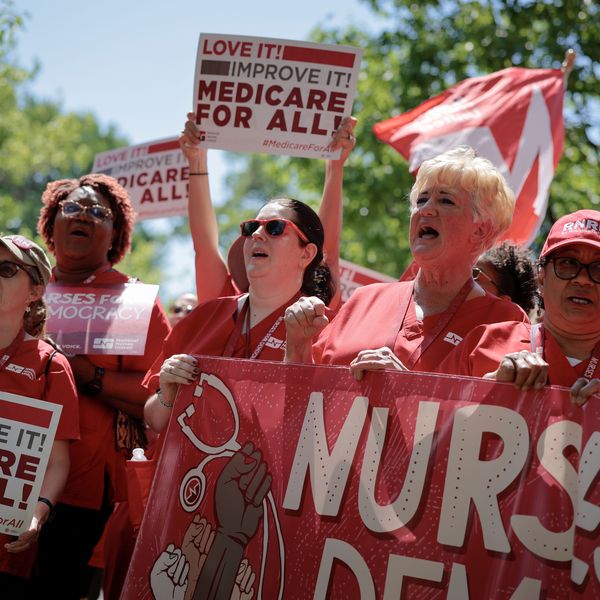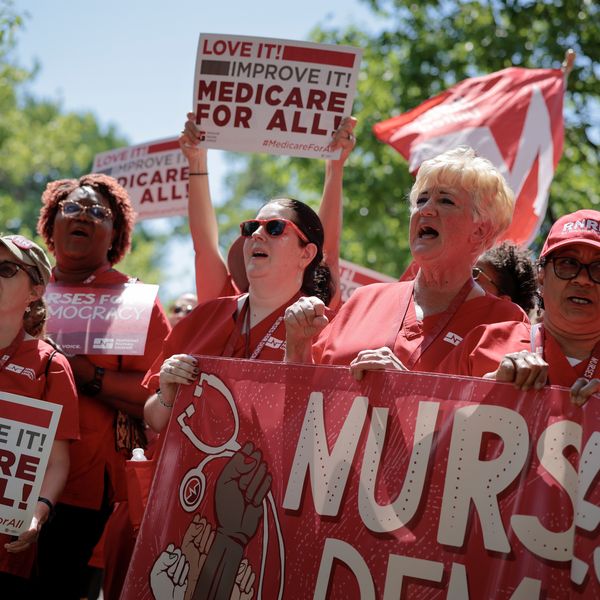The Obama transition team is asking you to help create a new health care policy. Really. Host a meeting, invite friends and associates, look at the Obama team's proposal, and let the transition team know what you decide.
If you are among a lucky few, Senator Tom Daschle, Secretary-designate
for Health and Human Services, may show up at your meeting.
This
may be more important than it sounds. The key dividing lines over how
to fix our country's broken health care system are becoming clear. It
may take the same sort of grassroots involvement that got Obama elected
president to keep the private insurance industry from hijacking the
process as they have during previous reform efforts.
Here's
one of the key decision points. The Obama plan calls for giving
everyone the option of signing up for a public or private insurance
plan. But according to The New York Times, the private insurance industry is lining up against that option. It's no small matter. According to a report released Wednesday by health policy analyst Jacob Hacker,
having a public option could make the difference between a system that
covers everyone and controls costs, and one that will continue to leave
millions out while costs soar.
As Americans
are painfully aware, our health care system is broken. 45 million
Americans or more are without health care coverage. Half of all
bankruptcies are caused, at least in part, by unaffordable health care
bills. We're spending more-16 percent of U.S. GDP (gross domestic
product) to cover 85 percent of our population, while Canada and France
each spend less than 10 percent of GDP to cover everyone.
The
harm to our economy of our backward health care system is especially
evident today, as all three U.S. auto makers suffer from the
competitive disadvantage of covering health care costs that their
overseas competitors can leave to more effective government-run
insurance programs.
Americans voted for change this November. But what system makes sense?
According to the research we did at YES! for our special coverage of health care reform, government involvement is critical. A majority of Americans agree-two out of three believe the government should provide national health care coverage, even if it would mean higher taxes. Other wealthy countries have adopted various methods, but a system like Canada's
is one of the most efficient at providing good coverage for everyone
while keeping a lid on costs. Under this system, the government is the
insurer, but patients choose their doctors from private, public, or
non-profit health care providers.
Having a
public system is the way to cut bureaucracy and cost. But government
involvement is where things get controversial. The private insurance
industry opposes such a move. And some say that the switch to national
insurance is too big a leap for Americans. People will be afraid to
give up the coverage they know for an unknown system.
So the Hacker proposal,
which was adopted in part by Barack Obama, may be the perfect
compromise. Keep your private insurance if you want. But if you aren't
covered, or if your premiums are too high, or your deductions and
exclusions are too onerous, you can opt for the public insurance
system. You would still choose your doctor. Subsidies would insure the
plan is affordable to all. At the lowest income levels, it would be
free.
Including a public system in our range
of options is what it will take to control costs, and thus make sure
everyone is included, according to Hacker. The private insurance
industry has made a lot of money by excluding things that are
expensive, shifting costs on to individuals and families by, for
example, excluding pre-existing conditions, and working to write
coverage only for those who are less likely to need health care. They
have a big incentive to figure out how to exclude a treatment or test
and little incentive to invest in our long-term health, since people
tend to shift insurance companies over time. Their business, after all,
is not keeping us healthy. It's generating profits for shareholders.
Medicare
has kept costs under control more effectively than either private
insurance companies, or pools of private insurers, like those who
contract with the federal government to provide health insurance to
federal employees. According to Hacker's report,
Medicare spending per enrollee increased only 4.6 percent per year from
1997 to 2006, while the cost of private insurance increased 7.3 percent
each year during the same time period.
Innovations
in the public sector have helped contain costs, and there are
substantial additional savings to be had from better use of information
technology, care coordination strategies, and databases of practices
and outcomes, according to Hacker.
And public health insurance agencies are in a better position to
negotiate for reasonable prices from private health care providers.
The nonpartisan Lewin Group estimates that Hacker's plan would save the U.S. economy $1 trillion over 10 years, while covering 99.6 percent of Americans.
The
Massachusetts system, enacted in 2006, is a stark example of what
happens when there is no public option. Everyone in the state is
supposed to be covered, but their choices are limited to private plans.
Premiums have been rising 8 to 12 percent per year, which means the
system will soon be out of reach of individual families, employers, and
the state government.
A public option assures
that there is a benchmark against which private companies must compete.
Without such a benchmark, private companies have no incentive to
contain costs or improve services.
It's hard to argue with giving people a choice.
But the health care industry is arguing. The New York Times says medical associations are encouraging their members to attend the health care discussion groups being organized by the Obama transition team
around the U.S. Past efforts to reform the health care system stalled
in the face of powerful health industry lobbyists with huge campaign
war chests. Will the industry be as adept at dominating the health care
policy discussion when it's happening in living rooms and coffee shops
around the country?
Here's how President-elect Obama put it at his December 11 press conference:
Year
after year, our leaders offer up detailed health care plans with great
fanfare and promise only to see them fail, derailed by Washington
politics and influence peddling.
If
Obama is able to bring together ordinary Americans, who so clearly are
desperate for change, and if they get as engaged in health care reform
as they were in the bottom-up presidential campaign, perhaps this time
we'll get the change we need. Maybe people power will overcome
corporate power, and we'll finally be able to join the rest of the
developed world who enjoy health care security.
So far, more than 4,000 meetings are scheduled around the U.S. Here's where you can sign up to lead a session. All the information you need is online, including the moderator's guide and instructions for reporting the results back to the transition team.
Note: If you are part of such a discussion, please let YES!
know. We'd love to read your report and post a selection. Send us an
email at editors [at] yesmagazine.org. Put the phrase "health care
discussion" in the subject line.


